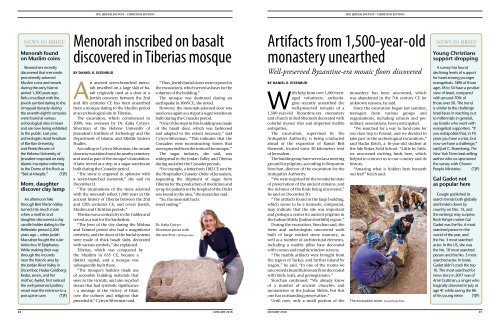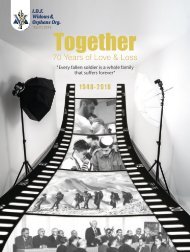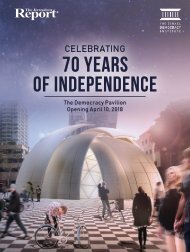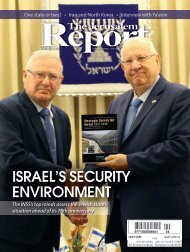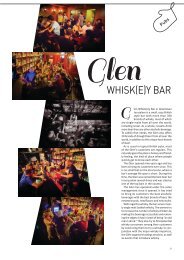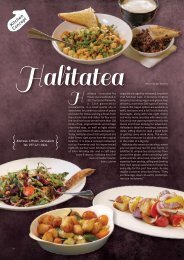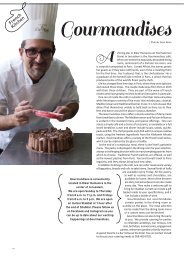CHE-_0_0_0_DoublePages+seg1
You also want an ePaper? Increase the reach of your titles
YUMPU automatically turns print PDFs into web optimized ePapers that Google loves.
THE JERUSALEM POST • CHRISTIAN EDITION<br />
THE JERUSALEM POST • CHRISTIAN EDITION<br />
NEWS IN BRIEF<br />
Menorah found<br />
on Muslim coins<br />
Researchers recently<br />
discovered that menorahs<br />
prominently adorned<br />
Muslim coins and vessels<br />
during the early Islamic<br />
period 1,300 years ago.<br />
Relics inscribed with the<br />
Jewish symbol dating to the<br />
Umayyad dynasty during<br />
the seventh-eighth centuries<br />
were found at various<br />
archeological sites in Israel<br />
and are now being exhibited<br />
to the public. Last year,<br />
archeologists Assaf Avraham<br />
of Bar-Ilan University,<br />
and Peretz Reuven of<br />
the Hebrew University of<br />
Jerusalem exposed an early<br />
Islamic inscription referring<br />
to the Dome of the Rock as<br />
“Beit al-Maqdis.” (TJP)<br />
Mom, daughter<br />
discover clay lamp<br />
An afternoon hike<br />
through Beit She’an Valley<br />
turned into much more<br />
when a mother and<br />
daughter discovered a clay<br />
candle-holder dating to the<br />
Hellenistic period 2,200<br />
years ago – when Judah<br />
Maccabee fought the ruler<br />
Antiochus IV Epiphanes.<br />
While making their way<br />
through the mounds<br />
near the historic area by<br />
the Jordan River Valley in<br />
December, Hadas Goldberg-<br />
Kedar, seven, and her<br />
mother, Ayelet, first noticed<br />
the well-preserved pottery<br />
vessel near the entrance to a<br />
porcupine cave. (TJP)<br />
Menorah inscribed on basalt<br />
discovered in Tiberias mosque<br />
BY DANIEL K. EISENBUD<br />
An ancient seven-branched menorah<br />
inscribed on a large slab of basalt<br />
originally used as a door at a<br />
Jewish cemetery between the 2nd<br />
and 4th centuries CE has been unearthed<br />
from a mosque dating to the Muslim period<br />
at an archeological site in Tiberias.<br />
The excavation, which commenced in<br />
2009, was overseen by Dr. Katia Cytryn-<br />
Silverman of the Hebrew University of<br />
Jerusalem’s Institute of Archeology and the<br />
Department of Islamic and Middle Eastern<br />
Studies.<br />
According to Cytryn-Silverman, the ornate<br />
doorway was taken from the nearby cemetery<br />
and used as part of the mosque’s foundation.<br />
It later served as a step in a sugar warehouse<br />
built during the Crusader period.<br />
“The stone is engraved in splendor with<br />
a seven-branched menorah,” she said on<br />
December 11.<br />
“The incarnations of the stone adorned<br />
with the menorah reflect 1,000 years in the<br />
ancient history of Tiberias between the 2nd<br />
and 12th centuries CE, and covers Jewish,<br />
Muslim and Christian periods.”<br />
Tiberias was a central city in the Galilee and<br />
served as a seat for the Sanhedrin.<br />
“The Jews of the city during the Mishna<br />
and Talmud period also had a magnificent<br />
cemetery, and the doors of the burial systems<br />
were made of thick basalt slabs, decorated<br />
with various symbols,” she explained.<br />
Tiberias, which was conquered by<br />
the Muslims in 635 CE, became a<br />
district capital, and a mosque was<br />
subsequently built there.<br />
“The mosque’s builders made use<br />
of accessible building materials that<br />
were in the vicinity, and also recycled<br />
stones that had symbolic significance<br />
– a message of the victory of Islam<br />
over the cultures and religions that<br />
preceded it,” Cytryn-Silverman said.<br />
“Thus, Jewish burial doors were exposed in<br />
the excavations, which served as bases for the<br />
columns of the building.”<br />
The mosque was destroyed during an<br />
earthquake in 1068 CE, she noted.<br />
However, the menorah-adorned door was<br />
used once again as a step at a sugar warehouse<br />
built during the Crusader period.<br />
“One of the steps in this building was made<br />
of the basalt door, which was fashioned<br />
and adapted to the extent necessary,” said<br />
Cytryn-Silverman. “This indicates that the<br />
Crusaders were reconstructing stones that<br />
were uprooted from the ruins of the mosque.”<br />
The sugar industry, she said, was<br />
widespread in the Jordan Valley and Tiberias<br />
during and after the Crusader periods.<br />
“For example, a letter from 1182 CE sent by<br />
the Hospitaller Crusader Order of Jerusalem,<br />
requesting the shipment of sugar from<br />
Tiberias for the production of medicines and<br />
syrup for patients in the hospital of the Order<br />
was found in the area,” the researcher said.<br />
“So, the menorah had a<br />
sweet ending.”<br />
Dr. Katia Cytryn-<br />
Silverman poses with<br />
the rare find. (Tal Rogovsky)<br />
Artifacts from 1,500-year-old<br />
monastery unearthed<br />
Well-preserved Byzantine-era mosaic floors discovered<br />
BY DANIEL K. EISENBUD<br />
With help from over 1,000 teenaged<br />
volunteers, archeologists<br />
recently unearthed the<br />
well-preserved remains of a<br />
1,500-year-old Byzantine-era monastery<br />
and church in Beit Shemesh decorated with<br />
colorful mosaic tiles and imported marble<br />
antiquities.<br />
The excavation, supervised by the<br />
Antiquities Authority, is being conducted<br />
ahead of the expansion of Ramat Beit<br />
Shemesh, located some 30 kilometers west<br />
of Jerusalem.<br />
The building may have served as a meeting<br />
ground for pilgrims, according to Benyamin<br />
Storchan, director of the excavation for the<br />
Antiquities Authority.<br />
“We were surprised by the wonderful state<br />
of preservation of the ancient remains, and<br />
the richness of the finds being uncovered,”<br />
he said on December 20.<br />
“The artifacts found in the large building,<br />
which seems to be a monastic compound,<br />
may indicate that the site was important<br />
and perhaps a center for ancient pilgrims in<br />
the Judean Shfela [Judean foothills] region.”<br />
During the excavation, Storchan said, the<br />
teens and archeologists uncovered walls<br />
built of large worked stone masonry, as<br />
well as a number of architectural elements,<br />
including a marble pillar base decorated<br />
with crosses and marble window screens.<br />
“The marble artifacts were brought from<br />
the region of Turkey, and further inland by<br />
wagon,” he said. “In one of the rooms we<br />
uncovered a beautiful mosaic floor decorated<br />
with birds, leafs, and pomegranates.”<br />
Storchan continued: “We already know<br />
of a number of ancient churches and<br />
monasteries in the Judean Shfela, but this<br />
one has outstanding preservation.”<br />
Until now, only a small portion of the<br />
monastery has been uncovered, which<br />
was abandoned in the 7th century CE for<br />
unknown reasons, he said.<br />
Since the excavation began last summer,<br />
teenagers from various groups and<br />
organizations, including schools and premilitary<br />
associations, have participated.<br />
“We searched for a way to fund-raise for<br />
our class trip to Poland, and we decided to<br />
take part in the archeological excavations,”<br />
said Hadas Keich, a 16-year-old student at<br />
the Sde Boker Field School. “Little by little,<br />
we uncovered exciting finds here, which<br />
helped to connect us to our country and its<br />
history.<br />
“Amazing what is hidden here beneath<br />
our feet!” Keich said.<br />
The excavation team. (Assaf Peretz/IAA)<br />
NEWS IN BRIEF<br />
Young Christians<br />
support dropping<br />
A survey has found<br />
declining levels of support<br />
for Israel among younger<br />
evangelicals. 58% of those<br />
ages 18 to 34 have a positive<br />
view of Israel, compared<br />
with around 70% of<br />
those over 50. The trend<br />
is similar to the challenge<br />
Israel faces in reaching out<br />
to millennials in general,<br />
say Israelis who work with<br />
evangelical supporters. “If<br />
you extrapolate that, in 10<br />
years you have a crisis, but<br />
now we have a challenge,”<br />
said Joel C. Rosenberg, The<br />
New York Times best-selling<br />
author who co-sponsored<br />
the survey with Chosen<br />
People Ministries. (TJP)<br />
Gal Gadot not<br />
as popular here<br />
Google published its<br />
search trends both globally<br />
and broken down by<br />
country on Dec. 13, and<br />
the rankings may surprise.<br />
Rosh Ha’ayin native Gal<br />
Gadot was the No. 6 most<br />
searched person in the<br />
world of the year, and<br />
the No. 3 most searched<br />
actor. In the US, she was<br />
the No. 10 most searched<br />
person and the No. 3 most<br />
searched actor. In Israel,<br />
Gadot didn’t crack the top<br />
10. The most searched-for<br />
news story in 2017 was of<br />
Amir Guttman, a singer who<br />
tragically drowned in July at<br />
age 41 while saving the life<br />
of his young niece. (TJP)<br />
14 JANUARY 2018<br />
JANUARY 2018 15


